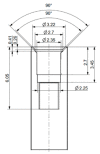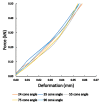Different Conical Angle Connection of Implant and Abutment Behavior: A Static and Dynamic Load Test and Finite Element Analysis Study
- PMID: 36903102
- PMCID: PMC10004464
- DOI: 10.3390/ma16051988
Different Conical Angle Connection of Implant and Abutment Behavior: A Static and Dynamic Load Test and Finite Element Analysis Study
Abstract
Dental implants are artificial dental roots anchoring prosthetic restorations to replace natural teeth. Dental implant systems may have different tapered conical connections. Our research focused on the mechanical examination of implant-superstructure connections. Thirty-five samples with 5 different cone angles (24°, 35°, 55°, 75°, and 90°) were tested for static and dynamic loads, carried out by a mechanical fatigue testing machine. Fixing screws were fixed with a torque of 35 Ncm before measurements. For static loading, samples were loaded with a force of 500 N in 20 s. For dynamic loading, the samples were loaded for 15,000 cycles with a force of 250 ± 150 N. In both cases, the compression resulting from load and reverse torque was examined. At the highest compression load of the static tests, a significant difference (p = 0.021) was found for each cone angle group. Following dynamic loading, significant differences (p < 0.001) for the reverse torques of the fixing screw were also shown. Static and dynamic results showed a similar trend: under the same loading conditions, changing the cone angle-which determines the relationship between the implant and the abutment-had led to significant differences in the loosening of the fixing screw. In conclusion, the greater the angle of the implant-superstructure connection, the smaller the screw loosening due to loading, which may have considerable effects on the long-term, safe operation of the dental prosthesis.
Keywords: FEA; conical angle; dental implants; dentistry; dynamic load; implantology; implant–abutment connection; screw loosening; static load; titanium implant.
Conflict of interest statement
The authors declare no conflict of interest.
Figures

















References
Grants and funding
LinkOut - more resources
Full Text Sources

